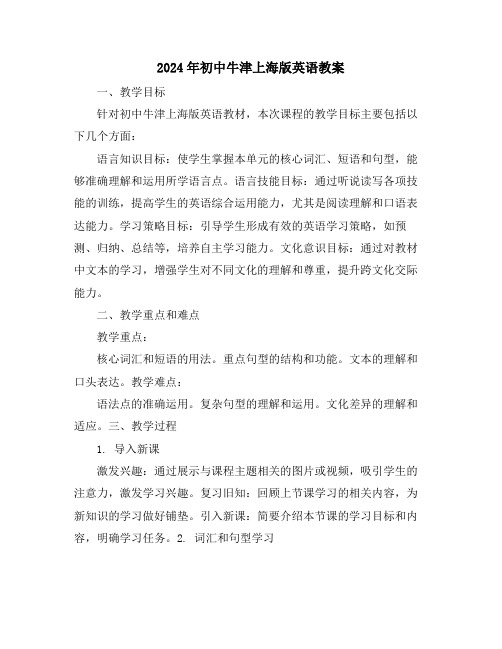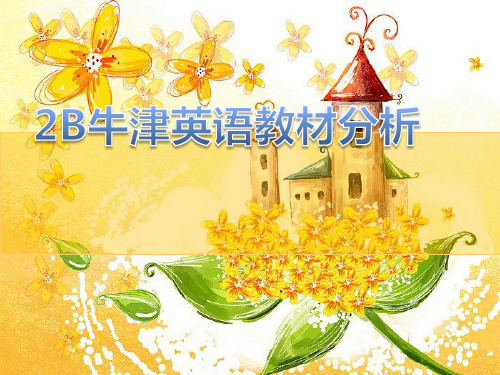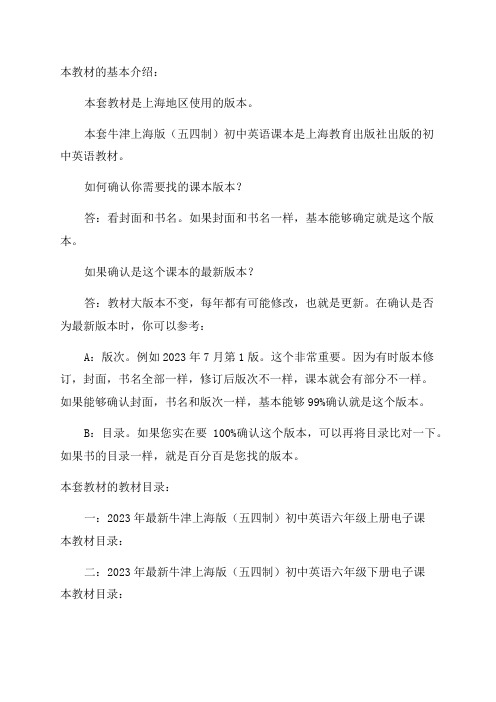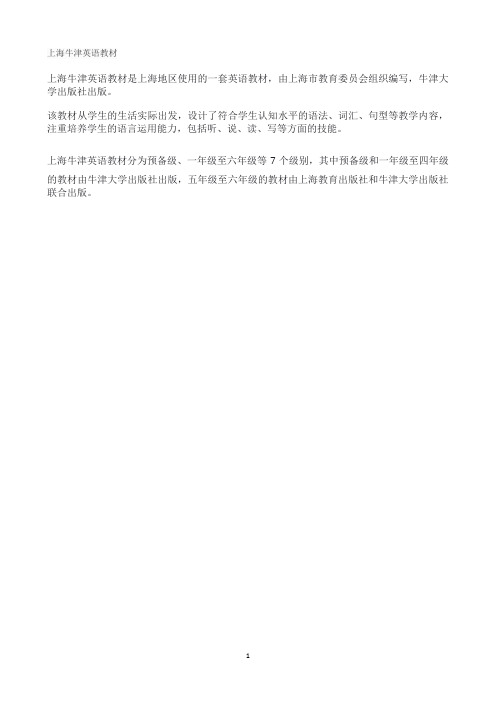牛津英语上海版教材
2024年初中牛津上海版英语教案

2024年初中牛津上海版英语教案一、教学目标针对初中牛津上海版英语教材,本次课程的教学目标主要包括以下几个方面:语言知识目标:使学生掌握本单元的核心词汇、短语和句型,能够准确理解和运用所学语言点。
语言技能目标:通过听说读写各项技能的训练,提高学生的英语综合运用能力,尤其是阅读理解和口语表达能力。
学习策略目标:引导学生形成有效的英语学习策略,如预测、归纳、总结等,培养自主学习能力。
文化意识目标:通过对教材中文本的学习,增强学生对不同文化的理解和尊重,提升跨文化交际能力。
二、教学重点和难点教学重点:核心词汇和短语的用法。
重点句型的结构和功能。
文本的理解和口头表达。
教学难点:语法点的准确运用。
复杂句型的理解和运用。
文化差异的理解和适应。
三、教学过程1. 导入新课激发兴趣:通过展示与课程主题相关的图片或视频,吸引学生的注意力,激发学习兴趣。
复习旧知:回顾上节课学习的相关内容,为新知识的学习做好铺垫。
引入新课:简要介绍本节课的学习目标和内容,明确学习任务。
2. 词汇和句型学习呈现新词汇:通过实物、图片或多媒体等方式呈现新词汇,帮助学生直观理解。
讲解词汇用法:详细解释新词汇的用法,包括词性、搭配等,并给出例句。
句型操练:通过替换、填空等方式,让学生操练重点句型,加深对句型的理解。
3. 文本理解和口头表达阅读文本:指导学生阅读教材文本,注意理解文本中的重点信息和语言点。
小组讨论:组织学生进行小组讨论,就文本内容展开讨论,培养口语表达能力。
汇报交流:每个小组选派代表汇报讨论成果,其他同学进行点评和补充。
4. 语法点讲解和练习呈现语法点:明确本节课的语法点,通过例句展示其用法。
讲解语法规则:详细解释语法点的构成和用法,帮助学生理解。
语法练习:设计多种形式的练习,如填空、选择、改写等,让学生充分练习。
5. 文化差异理解和适应对比文化:通过对比中英文化中的相似点和差异点,帮助学生理解文化差异。
讨论交流:组织学生就文化差异进行讨论交流,分享自己的见解和体验。
上海版小学英语牛津教材2B教材分析

Learn the letters: t-tiger, cat
Task: Different sounds (不同的声音) P13 A Colour and say (给你熟悉的物品涂上颜色,然后说一说它们发出什么声音) B Ask and answer(根据练习A的图,互相回答)
M2U2 My favourite food Review: soup, meat, hamburger, pizza, noodles, rice, biscuit Vocabulary: salad, carrot, fish, chicken, banana
Learn the letters: s-sun, bus z-zebra, zoo
Task: My favourite seson (我最喜欢的季节) P29 A Say and tick(说出你最喜欢的季节,然后根据它们的特点,在表格里打勾) B Colour and say (给下面的图上色,然后根据提示说一说)
M3U2
Rules
Vocabulary: light, go, stop, wait Drill: Look at ... It’s ...(2A) Let’s ... Learn the letters: m-mouth, jam n-nose, ten
Task: In the street (在街上) P33 A Listen and say (听录音,学儿歌) B Ask and answer (根据练习A的图,互相回答)
M3U3 My clothes Review:T-shirt, shorts, dress, blouse
Vocabulary: trousers, sweater, shirt, coat Further aims: jeans, skirt, jacket…
2023年最新版牛津上海版(五四制)初中英语全套课本介绍教材目录学习指南

本教材的基本介绍:本套教材是上海地区使用的版本。
本套牛津上海版(五四制)初中英语课本是上海教育出版社出版的初中英语教材。
如何确认你需要找的课本版本?答:看封面和书名。
如果封面和书名一样,基本能够确定就是这个版本。
如果确认是这个课本的最新版本?答:教材大版本不变,每年都有可能修改,也就是更新。
在确认是否为最新版本时,你可以参考:A:版次。
例如2023年7月第1版。
这个非常重要。
因为有时版本修订,封面,书名全部一样,修订后版次不一样,课本就会有部分不一样。
如果能够确认封面,书名和版次一样,基本能够99%确认就是这个版本。
B:目录。
如果您实在要100%确认这个版本,可以再将目录比对一下。
如果书的目录一样,就是百分百是您找的版本。
本套教材的教材目录:一:2023年最新牛津上海版(五四制)初中英语六年级上册电子课本教材目录:二:2023年最新牛津上海版(五四制)初中英语六年级下册电子课本教材目录:三:2023年最新牛津上海版(五四制)初中英语七年级上册电子课本教材目录:四:2023年最新牛津上海版(五四制)初中英语七年级下册电子课本教材目录:五:2023年最新牛津上海版(五四制)初中英语八年级上册电子课本教材目录:六:2023年最新牛津上海版(五四制)初中英语八年级下册电子课本教材目录:七:2023年最新牛津上海版(五四制)初中英语九年级上册电子课本教材目录:八:2023年最新牛津上海版(五四制)初中英语九年级下册电子课本教材目录:教辅学习与选择指南:在学习新课的时候,我们首先要使用的是全解类教辅或者解读类的教辅,对于教材中需要掌握的知识点有非常详细的讲解和总结,方便家长辅导,也方便学生自学。
完成了知识点的学习后,必要的课本配套练习也是必不可少的,这个时候可以使用课时练习类教辅,例如课课练、天天练、一课一练、配套练习册等。
在完成了一个阶段的学习后,就需要通过测试检验一下学习效果,这时就该轮到单元类或者结合类试卷类教辅上场了,包括了有周考卷、月考卷、单元卷、专题卷以及期中期末卷,能够让学生通过测试卷检验每一个阶段的学习效果。
牛津上海版高中英语教材目录汇总

G3
B
Module
Unit
1 Endangered animals (p.2)
1 Man and animals
2 Wonderful sea animals (p.18)
Using English: Differences between casual and formal English (p.34)
G1
B
Module
Unit
1 A trip to the theatre (p.2)
1 Extraordinary tales
1 Extraordinary tales 2 Great minds (p.18)
Using English:Writing notices (p.32)
3 Plants (p.34)
My favourite sport (p.3)
Adverbial phrases and clauses of purpose (p.6) Adverbial phrases and clauses of concession (p.7)
Understanding numbers (p.9)
4 Family celebrations (p.50)
Project: Planning a trip (p.66)
5 A tale with a twist (p.68)
3 A taste of literature
6 A Wilde play for love (p.75)
7 The poetry of nature (p.81)
3 Contemporary style (p.34)
2 Aspects of modern life
上海版牛津小学英语课本全部单词带音标

Pen 钢笔[pen] n pencil铅笔['pensəl] npencil-case铅笔盒['penslkeis] n ruler 尺子['ru:lə] neraser 橡皮[i'reizə] n crayon 蜡笔['kreiən] nbook 书[buk] n bag 书包[[bæɡ] nsharpener 卷笔刀['ʃɑ:pənə] n school 学校[sku:l] nhead 头[hed] n face 脸[feis] nnose鼻子[nəuz] n mouth 嘴[mauθ] neye 眼睛[ai] n ear 耳朵[iə] narm胳膊[ɑ:m] n finger 手指['fiŋɡə] nleg 腿[leɡ] n foot 脚[fut] nbody 身体['bɔdi] n red 红色的[red] nyellow 黄色的['jeləu] n green 绿色的[ɡri:n] nblue 蓝色的[blu:] n purple 紫色的['pə:pl] nwhite 白色的[hwait] n black 黑色的[blæk] n orange 橙色的桔子['ɔ:rindʒ] n pink 粉色的[piŋk] nbrown 棕色的[braun] n cat 猫;猫科动物[kæt] ndog 狗[dɔg] n monkey 猴子;顽童['mʌŋki] n panda 熊猫['pændə] n rabbit 兔子['ræbit] nduck 鸭子[dʌk] n pig 猪[piɡ] nbird 鸟;禽[bə:d] n bear 熊[bεə] nelephant 大象['elifənt] n mouse 老鼠[maus] nsquirrel 松鼠['skwə:rəl] n cake 蛋糕[keik] nbread 面包[bred] n hot dog 热狗hamburger汉堡包['hæmbə:ɡə] n chicken 鸡肉['tʃikin] n French fries 榨薯条[frentʃfraiz] n Coke 可乐[kəuk] njuice 果汁;汁[dʒu:s] n milk 牛奶[milk] nwater 水['wɔ:tə] n tea 茶[ti:] ncoffee 咖啡['kɔfi] n one一[wʌn] ntwo 二[tu:] n three 三[θri:] nfour 四[fɔ:] n five 五[faiv] nsix 六[siks] n seven 七['sevən] neight 八[eit] n nine 九[nain] nten 十[ten] n doll 玩具娃娃[dɔl] nballoon 气球[bə'lu:n] n car 小汽车[kɑ:] nplane 飞机[plein] n text 课文;文本[tekst] nself 自己;自我;本质[self] n word 单词;言辞;歌词[wə:d] n type 类型;样式;榜样[taip] n module 单元;组件['mɔdju:l] n daily 每日的;日常的['deili] a grammar语法['græmə] n content (书刊等的)目录;内容[kən'tent] n love 爱[lʌv] n expression 表达;表现力;表情[iks'preʃən] n wall 墙[wɔ:l] n project 方案;计划[prə'dʒekt] n dictionary 字典['dikʃəneri] n sheet 印刷品;表格[ʃi:t] n mum 妈妈(口语)[mʌm] n vocabulary 词汇;用词范围;词典[və'kæbjuləri] npoem (一首)诗['pəuim] n page 页[peidʒ] noral 口试['ɔ:rəl] n unit 单元;单位['ju:nit] nI am (我)是[æm] you 你[ju:] pronare (你)是[ɑ:] v come in. 进来['kʌm in]name 名字[neim] n class 班[klɑ:s ] ngood 好的[ɡud] n good morning! 早上好new新的;新闻[nju:] n we 我们[wi:] pronfrom 从……[frɔm] prep from beijing 从北京来的chair 椅子[tʃɛə] n floor 地板[flɔ:] nbox 盒子[bɔks] n at 在...;在……时[æt] prep zoo 动物园[zu:] n at the zoo 在动物园里park 公园[pɑ:k] n classroom 教室['klɑ:srum] n factory工厂['fæktəri] n square 广场[skwεə] ncapital首都['kæpitəl] n China 中国['tʃaɪnə] nthe capital of China 中国首都motherland 祖国['mʌðəlænd] n has有[hæz] (have的第三人称单数现在式)cap 帽子[kæp] n star 星;星号;星状物[stɑ:] n our我们的['auə] pronnational国家的['næʃənəl] n national flag国旗[flæɡ]coat上衣[kəut] n have有[hæv] vlong长的[lɔŋ] a short短的;矮的[ʃɔ:t] abig大的[biɡ] a small小的[smɔ:l] aor或;还是[ɔ:] conj guess 猜[ɡes] nhey 嗨[hei] int tall高的[tɔ:l] aold年老的[əuld] a young年轻的[jʌŋ] aChinese 中国的;汉语;中国人['tʃai'ni:z] over 越(过) ['əuvə] vEnglish英国的;英语;英国人['iŋgliʃ] there 那儿[ðεə] adover there 在那边join 参加[dʒɔin] nother另外的['ʌðə] pron an一(个) [æn] artapple苹果['æpl] n hand手[hænd] negg蛋[eɡ] n them 他(她;它)们(宾格) [ðem] pron umbrella 伞[ʌm'brelə] n school is over. 放学了home家[həum] n go home 回家rain 雨;下雨[rein] n it's raining. 正在下雨can't 不能[kɑ:nt] now 现在[nau] admuch许多;很;非常[mʌtʃ] a ad how much 多少eleven 十一[i'levən] num twelve十二[twelv] numminus 减['mainəs] prep a n here这儿[hiə] ad nHere you are. 给你money 钱;收入['mʌni] nthey 他(她;它)们[ðei] pron twenty 二十;二十年代['twenti] num these 这些[ði:z] pron door 门;出口[dɔ:] nwindow窗['windəu] n picture图画;照片['piktʃə] ntalk说话;谈论;演讲[tɔ:k] n about 关于[ə'baut] prepflower花;开花;精华['flauə] n some 一些[sʌm] pronboat 船;小船[bəut] n lake 湖[leik] nskirt 裙子;边缘;外围[skə:t] n clean 清洁的[kli:n] ashirt (男式)衬衫[ʃə:t] n dirty脏的['də:ti] acup 杯子;奖杯[kʌp] n glass玻璃杯[ɡlɑ:s] npicture-book 图画书have a look 看一看sure 当然;一定;可靠地[ʃuə] a ad and和[ænd] conjtheir 他(她;它)们的[ðεə] pron pioneer 先锋[,paiə'niə] nright对的[rait] a n young pioneer 少年先锋队员scarf 领巾[skɑ:f] n red scarf 红领巾all全部;都;尽可能的[ɔ:l] ad pron n both 两[bəuθ] pron peasant农民['pezənt] n soldier士兵;兵蚁['səuldʒə] n doctor医生;博士['dɔktə] n class is over下课了play 玩;演奏;表演[plei] v n there are 有what are they doing? 她们在做什么?do做[du:] v pingpong 乒乓球;桌球['piŋpɔŋ] n rainbow 彩虹['reinbəu] n American美国的,美国人[ə'merikən] Paper 纸;报纸;报告['peipə] n piece片[pi:s] n a piece of 一片;一张ink墨水[iŋk] n bottle瓶;酒['bɔtl] na bottle of 一瓶me我(宾格) [mi:] pronplease请[pli:z] v thank谢谢[θæŋk] v nwant要;想见;追捕[wɔnt] v write写[rait] vletter信['letə] n any任何['eni] pronThanks谢谢way路;路程[wei] ngo去[ɡəu] v go to the door 到门那儿去open开;开阔的['əupən] v close关;结账[kləuz] v blackboard黑板['blækbɔ:d] n clean把…弄干净[kli:n] vfootball足球;橄榄球['futbɔ:l] n Match比赛;对手[mætʃ] n between在(两者)之间[bi'twi:n] prep this afternoon今天下午[,ɑ:ftə:'nu:n] time时候;次;时代[taim] n have you any paper? 你有纸吗?what time? 什么时候?at three 在三时;在三点but但是;而是;然而[bʌt] conj jacket外衣;夹克;皮['dʒækit] n basketball篮球['bæskitbɔ:l] n TV电视radio 收音机;电台['reidiəu] n bat球拍;击球[bæt] nmaybe也许;可能['meibi] ad of course 当然[kɔ:s]knife小刀;手术刀;匕首[naif] n sorry对不起;抱歉['sɔri] intfor为;代替;因为;为得到[ fɔ:] prep can能够;可以;究竟[kæn] v.aux make做;制作;作出举动[meik] v right now立刻there is有;存在near 靠近[niə] ad prepplayground操场['pleiɡraund] n model模型;模特;模范['mɔdl] n model plane模型飞机model ship 模型轮船sky天空;天气;顶峰[skai] n bright明亮的;开朗的[brait] a above 在…上方[ə'bʌv] prep lesson功课;课程;教训['lesən] v have lessons上课like喜欢;愿意;希望[laik] v Like 爱好[laik] n table桌子['teibl] nlet让;出租[let] v artist 画家;艺术家['ɑ:tist] n house房子[haus] n tree 树;家谱[tri:] nriver河流;巨量['rivə] n front前面;前部;正面[frʌnt] n in front of 在…前面then那么;然后[ðen] adtcow母牛[kau] n behind在..后面[bi'haind] prep goose鹅[ɡu:s] n geese鹅(复数) [ɡi:s]moon月亮;月光[mu:n] n air 空气;天空;气氛[εə] n mountain山;山脉['mauntin] n think想;认为[θiŋk] vso这样;这么;所以['səu] ad give给;生产;出售[ɡiv] v animal动物['æniməl] n life 生命;生活[laif] nwhich 哪一个[hwitʃ] adv nineteen十九[,nain'ti:n] num thirty 三十['θə:ti] num twenty-one二十一['twenti,wʌn] thirty-three三十三['θə:ti'θri:] miss 女士;小姐;少女[mis] n people 人;人民;民族['pi:pl] n family家;家庭;家族['fæmili] n day白天;时代;……节日[dei] n week周;星期[wi:k] ntoday今天[tə'dei] n baby婴儿;幼畜['beibi] nsee看见[si:] v zebra斑马;有斑纹的['zi:brə] n run跑;行驶;运行;逃跑[rʌn] n jump跳[dʒʌmp] vall the time 一直count数[kaunt] v nlion狮子;勇敢的人['laiən] n tiger 老虎;凶残的人['taiɡə] nsit坐[sit] v exercise练习;运动['eksəsaiz] v down向下[daun] prep ad very很;非常['veri] adexercise-book 练习本out出;在外[aut] adout of 向(在)…外面listen听['lisən] vread读;察觉[ri:d] v after在…后面['ɑ:ftə] prepstop停止[stɔp] v n wait 等待[weit] vevening傍晚;晚上['i:vniŋ] n cinema电影院['sinəmə] n crossing 十字路口['krɔ:siŋ] n light 灯;光;火花;眼神['lait] n must必须;应该[mʌst] v.aux. yet还(没有)…还(不)…[jet] ad conj o'clock 点钟[ə' klɔk] morning早晨;上午['mɔ:niŋ] nget得到[ɡet] n up向上;上升;在……上面[ʌp] n get up起床half半[hɑ:f] n adpast过[pɑ:st] v morning exercises早操breakfast早餐['brekfəst] n eye-exercises 眼保操have a lesson上课draw画[drɔ:] vclock钟[klɔk] n tell 告诉;吩咐[tel] nher 她(宾格) [hə:] pron stand站;站立[stænd] vask 问;提问[ɑ:sk] v question问题['kwestʃən] nwell健康的[wel] a answer 回答['ɑ:nsə] vtalk in English 用英语交谈help 帮助;治疗[help] vquarter四分之一;一刻['kwɔ:tə] n game游戏[ɡeim] nstudy学习;研究;学问['stʌdi] n supper晚饭;晚餐会['sʌpə] n watch看;观看[wɔtʃ] v afraid 害怕的[ə'freid] aMr.先生(mister的缩写) ['mistə] n son儿子;女婿[sʌn] ndaughter女儿;媳妇;妇女['dɔ:tə] n newspaper报纸['nju:s,peipə] nby 在…旁;靠近prep play with 玩…sweep扫[swi:p] v floor地板;地面;……层[flɔ:] n mop擦;抹;拖[mɔp] v ready准备好了['redi] a adstill 还;仍旧[stil] ad lunch午餐[lʌntʃ] nroom房间[ru:m] n look for 寻找hurry匆忙;赶紧['hʌri] v n hurry up! 快点!fox狐狸;狡猾的人[fɔks] n news消息;新闻[nju:z] ncome this way 往这边来away离……;外出[ə'wei]run away 跑掉giraffe 长颈鹿[dʒi'rɑ:f] nwhy (表吃惊;满意等)哎呀!为什么?[hwai] adv noise 噪声[nɔiz] n pineapple 菠萝;凤梨['pain,æpl] n lorry 卡车['lɔ:ri] nlime 酸橙;菩提树[laim] n lizard 蜥蜴['lizəd] nboard 写字板;牌子;伙食[bɔ:d] n computer 计算机[kəm'pju:tə] n teacher’s desk 讲台fan扇子;电扇;螺旋桨[fæn] n classmate同学['klɑ:smeit] n good idea好主意[ai'diə]all right好吧;好的seat座位[si:t] ngood job 干的好[dʒɔb] what什么;(感叹)多少[hwɔt] pron int look at 看……Chinese book 语文书fat胖的;厚的;大量的[fæt] a heavy重的;沉重的['hevi] amay可以[mei] v.aux. long hair 长头发[hεə]short hair 短头发thin 瘦的;细的;薄的[θin] a strong 健壮的;坚固的[strɔŋ] a quiet 安静的['kwaiət] ahis 他的[hiz] pron photo 照片['fəutəu] nteacher 教师['ti:tʃə] n Student(大中学)学生['stju:dənt] n music音乐['mju:zik] n science科学;技术['saiəns] nsports 体育运动[spɔ:ts] n computer game电脑游戏painting 绘画;上油漆['peintiŋ] v boy 男孩;儿子;小儿子[bɔi] ngirl女孩;女儿[ɡə:l] n bathroom 卫生间;浴室['bæθrum] n bedroom 卧室['bedrum] n kitchen 厨房['kitʃin] nfridge 冰箱[fridʒ] n key钥匙[ki:] nrice米饭[rais] n noodle(s) 面条(通常复数)['nu:dl] n hungry饥饿的['hʌŋgri] a chopsticks筷子(复数)['tʃɔpstik] n horse 马[hɔ:s] n spoon 勺子[spu:n] nplate 盘子[pleit] n fork 叉子;岔口[fɔ:k] npass 传递;经过;度过[pɑ:s] v Try试;试一下[trai] vHelp yourself 随便吃show 展示;演出[ʃəu] nfood 食物[fu:d] n parents 父母['pєərənts] nuncle 叔叔舅舅姨夫姑父['ʌŋkl] n aunt 姑姑;婶;姨[ɑ:nt] nmember 成员['membə] n only 只有;仅仅['əunli] apuppy 小狗['pʌpi] n sister 姐妹['sistə] nfarmer 农民['fɑ:mə] n nurse 护士[nə:s] nit 它[it] pron class 课程[klɑ:s] ndress 连衣裙[dres] n T-shirt T恤衫no 不;不是[nəu] ad not 不;不是的[nɔt] adwarm 暖和的[wɔ:m] a cold 寒冷的[kəuld] acool 凉爽的[ku:l] a jean 牛仔裤;斜纹棉布[dʒi:n] n pant 长裤[pænt] n Sock(s) 袜子(复数)[sɔk] n Shoe(s) 鞋子(复数)[ʃu:] n snowy 下雪的['snəui] asunny晴朗的['sʌni] a banana 香蕉[bə'nɑ:nə] npear梨[pεə] n watermelon 西瓜['wɔ:tə,melən] n Monday 星期一['mʌndi] n Tuesday星期二['tju:zdi ] n Wednesday星期三['wenzdei ] n Thursday ] 星期四['θə:zdi] n Friday星期五['fraidi] n Saturday星期六['sætədi] n Sunday星期天['sʌndi] n raindrop 雨点['reindrɔp] nrobot 机器人['rɔbət] n good 好的[gud] nfriend朋友[frend] n hear 听;听见[hiə] vwork工作[wə:k] n walk 走路;步行[wɔ:k] v excuse me. 对不起!请原谅![iks'kju:z] take 拿;乘[teik] v take a no.7 bus 乘七路公共汽车trolley-bus 无轨电车['trɔlibʌs] n underground. 地铁['ʌndəgraund] n number 号;号码['nʌmbə] n England英国['inglənd] n America美国;美洲[ə'merikə] n by underground 乘地铁bus stop 公共汽车站[stɔp]Catc(bus) 赶上;抓住[kætʃ] v fish 鱼[fiʃ] nnest 鸟巢[nest] n swim 游泳[swim] vsing 唱;唱歌[s iŋ]dance跳舞;舞蹈['dɑ:ns] v volleyball排球['vɔlibɔ:l] speak 说[spi:k] vlittle少许;一点点;幼小['litl] a a little 少许;一点点owl 猫头鹰[aul] n each每个各自的[i:tʃ] pron ad each other 互相['ʌðə] begin 开始[bi'gin]like像[laik] prep Russian俄语,俄国人['rʌʃən]so much like 很像dark 黑暗[dɑ:k] nsay说[sei] v after all 究竟;到底often 经常;常常['ɔ:fən] ad child小孩[tʃaild] nchildren 小孩(复数) ['tʃildrən] n palace宫殿['pælis] na lot of 许多…fun乐趣;娱乐[fʌn]every每个的['evri] a early早,早的['ə:li] awash洗[wɔʃ] v brush刷(子) [brʌʃ] ntooth 牙[tu:θ] n teeth牙(复数) [t i:θ] nfar远[fɑ:] a n usually通常['ju:ʒuəli] adsummer夏天['sʌmə] n winter冬季;冬天['wintə] nskate 滑冰[skeit ] v buy买[bai]vsize 大小;尺寸;号码[saiz] n try on 试穿fast 快[fɑ:st] a will将[wil] v.aux.hare野兔[hєə] n tortoise乌龟['tɔ:təs] nrace比赛[reis] n have a race 赛一赛get到达[get] v get there 到那里got (动词get的过去式) [gɔt] sleep 睡觉[sli:p] vfirst第一;首先[fə:st] num win赢;获胜[win] vrest休息[rest] v Mr. and Mrs. white 怀特先生和夫人welcome欢迎;受欢迎的['welkəm] int forty四十['fɔ:ti] numforty-two四十二very much 非常adonly仅仅唯一的['əunli] ad bell铃,铃声[bel] vit's time for 是…的时候了back后面[bæk] nat the back 在后面when什么时候[(h)wen] advbegin classes 开始上课month月[mʌnθ] nbasin 盆;脸盆['beisən] n once一次[wʌns] ad nonce a week 每周一次group 组;小组[gru:p] npool 池[pu:l] n swimming-pool 游泳池man男子[mæn] n him他(宾格) [him] pronwoman妇女['wumən] n her 她(宾格) [hə] pronbring带来;拿来[briŋ] vt us 我们(宾格) proncall 叫[kɔ:l] v dad 爸爸[dæd] ncabbage卷心菜['kæbidʒ] n pair 一双[pєə] na pair of 一双…yours你的;你们的[juəz] pronempty 空的['empti] a mine我的[main] pronwhose 谁的[hu:z] pron trousers 裤子;长裤['traʊzəz] na pair of trousers 一条裤子ours 我们的['auəz] prontheirs他(她;它)们的[ðєəz] pron wear 穿戴[wεə] nblouse (女式)衬衫[blauz] n hers 她的[hə:z] pronground地面[graʊnd] n pick 采;摘[pik] vpick up 拾起put into 放到…里may i have a try? 我可以试试吗eat breakfast 吃早饭[i:t] ['brekfəst] do morning exercises 晨练['mɔ:niŋ] ['eksəsaiz] n noon 中午[nu:n] n have English class上英语课[hæv] ['iŋgliʃ] [klɑ:s] spring 春天[spriŋ] n play sports进行体育运动[plei] [spɔ:ts] fall 秋天[fɔ:l] n climb mountains 爬山[klaim] ['mauntins] date 日期[deit] n visit grandparents看望祖父母['vizit] ['græn,pєərənts] study 书房['stʌdi] n play the piano弹钢琴[plei] [pi'ɑ:nəu] make a snowman 堆雪人['snəʊmæn] go shopping 购物[gəu] ['ʃɔpiŋ]fly kites 放风筝[flai] [kait]skate 滑冰(鞋)[skeit] n go hiking 去远足['haikiŋ]weekend周末['wi:kend] n sometimes 有时候['sʌmtaimz] ad birthday生日['bə:θdei] n season 季节['si:zn] ncook dinner做饭[kuk] ['dinə] best 最;极[best] a adread a book 看书[rid] plant trees 种树[plɑ:nt] [tri:s] because 因为[bi'kɔz] conj mirror 镜子;榜样['mirə] ndraw pictures 画画[drɔ:] ['piktʃəz] grandpa 爷爷;外公['grændpɑ:] n grandma 奶奶;外婆['grændmɑ:] n kangaroo袋鼠[,kæŋgə'ru:] n answer the phone 接电话['ɑ:nsə] [fəun] fight 打架[fait] v listen to music听音乐['lisn] ['mju:zik] honey蜂蜜['hʌni] n clean the room打扫房间[kli:n][rum] write a letter写信[rait] ['letə]write an e-mail写电子邮件climb 往上爬[klaim] vswing 荡;荡秋千[swiŋ] v drink water 喝水[driŋk] ['wɔ:tə] take pictures 照相[teik] ['piktʃəz] scarf 围巾;领带[skɑ:f] nwatch insects 观察昆虫[wɔtʃ] ['insekt] chess 西洋棋[tʃes] n pick up leaves 采摘树叶[pik] [ʌp] [li:vz] traffic 交通['træfik] ndo an experiment做实验[du:] [æn] [iks'perimənt] stop停车站[stɔp] n catch butterfly 捉蝴蝶[kætʃ] ['bʌtəflai] hobby 爱好['hɔbi] n count insects 数昆虫[kauʊnt] collect leaves 收集树叶[kə'lekt]play chess下棋[plei][tʃes] have a picnic 举行野餐['piknik] write a report写报告[rait][ri'pɔ:t] shell 贝壳;果壳[ʃel] ntraffic light 交通灯[lait] traffic rule交通规则ru:l]get to 到达[get] [tu] library 图书馆['laibrəri] nwhere 在哪里;到哪里[(h)wєə] ad pron turn 转弯[tə:n] v next to 与……相邻[nekst] bookstore 书店['bukstɔ:] npost card 明信片[pəu st] [kɑ:d] n right 右边[rait] nleft 左边[left] n straight 成直线地[streit] athis morning 今天上午[ðis] ['mɔ:niŋ]next week 下周[wi:k]this afternoon 今天下午[ðis] ['ɑ:ftə'nu:n] go→goes 去[gəʊz] his evening今天晚上[ðis] ['i:vniŋ]comic book 漫画['kɔmik] [buk] comic连环图画;喜剧的['kɔmik] n dive→diving 跳水[daiv]ride a bike→riding a bike 骑自行车[raid] writer 作家['raitə] n play the violin→playing the violin 拉小提琴['pleiiŋ] [,vaiə'lin]make kites→making kites 制作风筝[meik] [kait] fly飞[flai] v collect stamps→collecting stamps 集邮[kə'lekt] [stæmps]should 应该[ʃud ] v.aux live→lives 居住[liv ] [laivz]t each→teaches 教[ti:tʃ] watch→watches看[wɔtʃ]read→reads 读;看[rid] doesn’t=does not [dʌz ]singer 歌唱家;歌手['sindʒə] n actor 男演员['æktə] nactress女演员['æktris] n TV reporter 电视台记者[ri'pɔ:tə] engineer工程师[,endʒi'niə] n accountant会计[ə'kauntənt] n policeman 男警察[pə'li:smən] n salesperson销售员['seilz,pə:sən] n cleaner清洁工['kli:nə] n work 工作;活动[wə:k] vcloud 云[klaud] n sun 太阳[sʌn] nstream 河;溪[stri:m] n come from 来自[kʌm] [frɔm]seed 种子[si:d] n soil 土壤[sɔil] nsprout 苗;芽[spraut] n plant 种植[plɑ:nt] vttall → taller更高的[tɔ:l] short → shorter 更矮的[ʃɔ:t] strong → stronger 更强壮的o ld → older 年龄更大的[əuld] young → younger 更年轻的[jʌŋ]big → bigger 更大的[big]heavy → heavier 更重的['hi:vi] long → longer 更长的[lɔŋ]thin → thinner 更瘦的[θin]small → smaller 体型更小的[smɔ:l] have a fever 发烧[hæv] ['fi:və] have a sore throat 喉咙疼[sɔ:] [θrəut] have a cold 感冒[kəuld] have a toothache 牙疼['tu:θeik]have a headache 头疼['hedeik] sore 疼的[sɔ] amatter 事情;麻烦['mætə] n hurt 疼痛[hə:t] n vtired 疲劳的;累的['taiəd] a excited 兴奋的[ik'saitid] aangry 生气的['æŋgri] a happy 高兴的['hæpi] abored 无聊的;烦人的[bɔ:d] a sad 忧伤的;悲伤的[sæd] awatch → watched 看[wɔtʃ] wash → washed 洗[wɔʃt]clean → cleaned 打扫[kli:n] play → played 玩[plei]go to a park →went to a park 去公园[pɑ:k] row划;划船[rau] v go swimming→went swimmin去游泳['swi miŋ]ski滑雪,雪橇[ski] n go fishing →went fishing 去钓鱼['fiʃiŋ]snake 蛇[sneik] n eat good food →ate good food 吃好吃的食物soft 柔软[sɔft] ago hiking →went hiking 去郊游['haikiŋ]wind 风[waind] n take pictures →took pictures 照相[teik] [tuk] wolf 狼[wulf] nlast 上一个的;仅余的;留在最后的[lɑ:st] glove 手套[glʌv] n go ice-skating → went ice-skating 去滑冰[ais] grey 灰色[grei] n row a boat →rowed a boat 划船[rau] [bəut] taste 尝[teist] vtsee elephant →saw elephant 看大象([si:] )[sɔ:] loud 响的[laud] ago skiing → went skiing 去滑雪[ 'ski:iŋ]bell 铃;门铃[bel] n sing and dance →sang and danced 唱歌和跳舞[siŋ] ['dɑ:ns] sæŋ]learn Chinese →learned Chinese 学汉语[lə:n] ['tʃai'ni:z] ['lə:nid]visit → visited 看望['vizit] do → did last weekend 上个周末go → went 去[gəu] [went] hiking徒步旅行['haikiŋ] n vclimb → climbed 爬klaim] smell 嗅闻[smel] vtget → got 到达[get] [gɔt] how 怎么;如何[hau] adshine 照耀;发光[ʃain] vi wave 浪;波浪[weiv] ntoy 玩具;玩物[tɔi] n parrot 鹦鹉['pærət] naeroplane 飞机['ɛərəplein] n roof 屋顶;车顶[ru:f] nsweet 甜的;悦耳的[swi:t] a colour 给……颜色['kʌlə] vdrill 钻头钻床[dril] n dry 干的干旱的[drai] ablow 吹[bləu] vt vi insect 昆虫['insekt] nambulance (man) 急救员['æmbjuləns] n angry 发怒['æŋgri] aaviary 鸟巢禽舍['eiviəri] n block 大楼;大厦[blɔk] nbranch 树枝[brɑ:ntʃ] n brave 勇敢的[breiv] nbus driver 司机['draivə] n butter 黄油;奶油['bʌtə] nchase 追赶[tʃeis] v chocolate 巧克力['tʃɔkəlit] ncoffee 咖啡['kɔfi] n cook 厨师[kuk] ncook 烹调;煮[kuk] v corm 谷物[kɔ:m] ncrisp 松脆饼干;松脆之物[krisp] n cut 切;割;砍kʌt] vdear 亲爱的;可爱的[diə] a dentist 牙医['dentist] neighteen 十八['ei'ti:n] num eleven 十一[i'levn] numengine 引擎;发动机['endʒin] n everywhere 到处;彻底['evrihwɛə] adv farm 农场[fɑ:m] n feed 喂养;饲养[fi:d] vfifteenth 十五['fif'ti:nθ] num fire 火[faiə] nfireman 消防员['faiəmən] n flour 面粉;粉状物质[flauə] n fountain 喷水池;泉水['fauntin] n fourteen 十四['fɔ:'ti:n] numfrog 青蛙[frɔg] n fruit 水果;果实[fru:t] nfull 饱的;充满的[ful] a grass 草;草坪[grɑ:s] nhay 干草[hei] n hoop 呼啦圈;戒指;篮圈[hu:p] n knee 膝盖;膝部[ni:] n large 大的;宽大的[lɑ:dʒ] aleave 离开[li:v] v log 原木;木材[lɔg] nmask 面具;遮蔽物;口罩[mɑ:sk] n moth 蛾;蛀虫[mɔθ] npacket 小包['pækit] n policewoman 女警[pə'li:s,wumən] n postman 邮递员['pəustmən] n rectangle 长方形[rek'tæŋgl] nride 骑;乘[raid] v rope 绳子[rəup] nround 圆的[raund] a rubbish 垃圾;废话['rʌbiʃ] nseventeen 十七[,sevn'ti:n] num sharp 尖的;锋利的[ʃɑ:p] asheep 羊;害羞的人;蠢人[ʃi:p] n See you 再见birthday 生日['bə:θd ei] n Oh no 噢;不[əu]I’m……years old 我……岁shop assistant 营业员[ə'sistənt] n shoulder 肩['ʃəuldə] n sixteen 十六['siks'ti:n] num sketchbook 写生簿;小品集['sketʃbuk] n stalk 主茎[stɔ:k] n stone 石头[stəun] n sugar 糖['ʃugə] nsunglasses 太阳镜['sʌnglɑ:siz] n supermarket 超市['sju:pə,mɑ:kit] n telephone 打电话['telifəun] v There be 有thirteen 十三['θə:ti:n] num throw 扔;转动(开关)[θrəu] v toe 脚趾;足尖[təu] n trunk 树干;大皮箱[trʌŋk] nunder在……下面['ʌndə] prep waiter 服务员(男)['weitə] nYou can call me……(name) 你可以叫我……April 四月['eiprəl] n waitress 女服务员['weitris] n afternoon 下午;午后['ɑ:ftə'nu:n] n How much is it? 多少钱……yuan.please 请付……元I’m sorry. That’s all right 对不起。
牛津上海版七年级英语上册《Module1Unit2Listeningandspeaking》说课稿

牛津上海版七年级英语上册《Module 1 Unit 2 Listening and speaking 》说课稿一. 教材分析《牛津上海版七年级英语上册》Module 1 Unit 2 Listening and speaking部分,主要围绕“询问和描述日常活动”这一主题展开。
通过本节课的学习,学生能够掌握相关词汇和句型,如“What time do you get up?”, “I usually go to school by bus.”等,并能够运用这些词汇和句型进行简单的日常交流。
教材内容贴近学生的生活,有助于激发学生的学习兴趣,提高学生的语言运用能力。
二. 学情分析七年级的学生已具备一定的英语基础,对于日常生活中的基本词汇和句型有所了解。
但部分学生对英语学习的兴趣不足,课堂参与度不高。
因此,在教学过程中,教师需要关注学生的学习兴趣,调动学生的积极性,引导他们主动参与课堂活动。
三. 说教学目标1.知识目标:学生能够掌握询问和描述日常活动的相关词汇和句型。
2.能力目标:学生能够运用所学词汇和句型进行简单的日常交流。
3.情感目标:激发学生对英语学习的兴趣,提高他们的自信心。
四. 说教学重难点1.重点:掌握询问和描述日常活动的相关词汇和句型。
2.难点:能够运用所学词汇和句型进行简单的日常交流。
五. 说教学方法与手段1.任务型教学法:通过设定具体任务,引导学生参与课堂活动,提高学生的语言运用能力。
2.情境教学法:创设生活情境,让学生在真实的环境中感受和运用英语。
3.多媒体辅助教学:利用多媒体课件,丰富教学手段,提高学生的学习兴趣。
六. 说教学过程1.导入:以歌曲“What time is it?”导入课堂,激发学生的学习兴趣。
2.新课呈现:通过展示日常活动的图片,引导学生说出相关词汇,如“get up”, “go to school”等。
3.句型练习:让学生分组进行角色扮演,运用所学句型进行交流。
牛津上海版英语六年级上教材梳理及练习 Unit2

Unit2一、词汇Words1. almost adv.(1)几乎【例句】Dinner is almost ready.(2)实际上,简直(用于no, nobody, none, nothing, never 之前)【例句】Almost no one believed him.【辨析】almost / nearly相同点:“几乎,将近,差不多”,当于动词、副词、形容词及名词连用时,意义接近,可互换。
【例句】It's nearly lunchtime.= It's almost lunchtime.2. never adv. 从不; always adv. 总是,一直【例句】She is always friendly and helpful.She always works hard.She is never late for school.She never gets angry.注意always 和never在句中的位置,它们都是副词常用于be动词之后、行为动词之前。
3. each other 互相,彼此【例句】Mary and Kitty always help each other.【常见词组】learn from each other 互相学习know each other 互相认识help each other 互相帮助【知识链接】each other 仅用作动词或介词的宾语,不可做主语。
【用法提示】each other 用于两者,one another 用于三者或三者以上。
each other one another(选词填空)I help you. You help me. We help __________.They three sat side by side and talked with ___________.4. friendly adj. 友好的【用法提示】friendly 常与介词to 和with 搭配构成词组1)be friendly to sb.“ ... 对某人友好”或“ 对某人友善”,指对别人的态度友好,相当于be kind to sb. 【例句】Our English teacher is friendly to us.=Our English teacher is kind to us.2)be friendly with sb. “ 和某人关系友好” 或“ 与某人要好”, 指的是两者的关系。
上海牛津英语教材

上海牛津英语教材
上海牛津英语教材是上海地区使用的一套英语教材,由上海市教育委员会组织编写,牛津大学出版社出版。
该教材从学生的生活实际出发,设计了符合学生认知水平的语法、词汇、句型等教学内容,注重培养学生的语言运用能力,包括听、说、读、写等方面的技能。
上海牛津英语教材分为预备级、一年级至六年级等7个级别,其中预备级和一年级至四年级
的教材由牛津大学出版社出版,五年级至六年级的教材由上海教育出版社和牛津大学出版社联合出版。
1。
